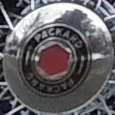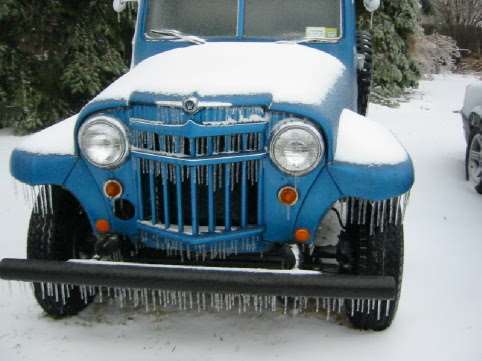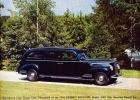|
Re: Hesitation on initial acceleration
|
||||
|---|---|---|---|---|
|
Home away from home

|
Hi Guy,
Regarding your oil light flickering at idle, that's normal according to the Packard owner's manual, page 7; the manual is viewable on this site. I've read that oil pressure lights come on when the pressure drops to 6 psi. As the oil warms up and thins out the pressure may drop but the volume of oil circulating does not, so the engine is being adequately oiled even at that low a pressure. My car does that also, after the engine is warmed up fully; I can make it go out by shifting into neutral (Ultramatic.) Although I was glad to read that in the manual, it took quite a while before I could look at that light and not be concerned. The manual does go on to state that the light should go out when the engine speed is increased; if it remains on after the increase the engine should be shut down and the cause of the trouble determined and corrected. Regarding the fuel and temp gauges, the 54th series wiring diagram shows they are connected to the instrument voltage regulator and then to a 10 amp circuit breaker located on the back of the instrument cluster near the gauges. I'll leave your driveability concern to others who are better versed in the ins and outs of carburetion.
Posted on: 2014/7/24 1:08
|
|||
|
Don Shields
1933 Eight Model 1002 Seven Passenger Sedan 1954 Convertible |
||||
|
||||
|
Re: Hesitation on initial acceleration
|
||||
|---|---|---|---|---|
|
Home away from home

|
Hi 55:
Maybe try 10w-30 with the next oil change. I wouldn't worry about lead substitutes in your car unless you are cruising over 75mph across the Mojave desert. As for the throttle, look for a worn throttle rod bore at the carburetor causing binding of the butterflies. If the bore has wear a second spring pulling the shaft forward should fix the binding until you get the carburetor rebuilt.
Posted on: 2014/7/24 4:02
|
|||
|
||||
|
Re: Hesitation on initial acceleration
|
||||
|---|---|---|---|---|
|
Home away from home

|
"In addition to a stiff accelerator, there is a "dead spot" just off-idle that seems to be a lean condition. The accelerator pump was just replaced, which helped this condition a bit, but it still seems to be a factor in smooth acceleration."
I would look into a possible intake runner leak or worn throttle shafts/bushing ( which may also be the culprit of the sticking linkage). A vacuum leak at either will give you the lean condition and the hesitation that you are experiencing. James
Posted on: 2014/7/24 8:55
|
|||
|
||||
|
Re: Hesitation on initial acceleration
|
||||
|---|---|---|---|---|
|
Home away from home
|
If you pull the dash panel forward (remove the hot wire from the battery first, and then the speedometer cable), you can take off the circuit breaker easily and take it to NAPA for a replacement. Just keep in mind that the new one will be marked "BAT" which is for a negative ground, so just install it backwards. It will also be marked 12 volt, but circuit breakers don't care what the voltage is. The Napa number is 30055-10 and they cost $6.29. Easy to swap out.
Posted on: 2014/7/24 13:53
|
|||
|
||||
|
Re: Hesitation on initial acceleration
|
||||
|---|---|---|---|---|
|
Home away from home

|
Quote:
Tim, Quote: unless you are cruising over 75mph across the Mojave desert. I might actually be doing something similar to that, like cruising 65 on Route 66 to Arizona at the end of August. That's the plan, anyway. However, I don't get how 10w-30 could help. Straight weights are said to stay heavier when warm. (My oil ideas are over on the "New available motor oil" thread on the V8 forum.) Thanks for your info on that extra spring, I'll experiment with that. AND THANKS EVERYBODY FOR COVERING MY QUESTIONS SO WELL! I can see how valuable this site is for anyone with a Packard. It was interesting to me before I got the '54 Clipper, but now it is indispensable. The dash pulling instructions and PN number from David are going to save me, like, 8 hours or so??
Posted on: 2014/7/26 13:33
|
|||
|
Guy
Not an Expert |
||||
|
||||
|
Re: Hesitation on initial acceleration
|
||||
|---|---|---|---|---|
|
Home away from home
|
Stiff and or sticky accelerator in the 51-54 cars is almost always caused by the bracket on the firewall just above the gas pedal mechanism. Originally it was rubber bushed at its lower end and held the cross shaft a good oh, two inches away from the firewall. Over the 60 years the pressure of the return spring has caused it let the cross shaft fall almost back against the firewall which screws up the geometry and also makes the return spring ineffective.
The easiest and quite effective fix for this is to just shove some old shock absorber bushing or other hunk of rubber between the vertical support and the firewall so that the cross shaft moves well away from the firewall. This will restore the geometry and make for a much smoother gas pedal action. Repair time: approx 30 seconds.
Posted on: 2014/7/26 20:35
|
|||
|
||||
|
Re: Hesitation on initial acceleration
|
||||
|---|---|---|---|---|
|
Home away from home

|
While the viscosity of 30w oil may be slightly higher at 100C than 10w-30 the viscosity index is usually lower.
For example, the viscosity index of SuperFlo 10w-30 is 135 while the index of Valvoline 30w is 95. Thus, a multi-grade oil should provide more stable oil pressure. The general rule for oil pressure is 10 psi per 1000 rpm. Some confusion exists because straight grade motor oils are frequently labeled "heavy duty". This doesn't mean they have more stamina. What they are intended for are low rpm applications where there is low likelihood of foaming. For example, a diesel generator may sit and run constantly at 2000 rpm. It is a heavy duty piece of equipment. Fork lift builders like to specify 30w oil for their motors. Maybe over 75mph in the Mojave is too mild for lead additives. Perhaps high rpm flat tracking is more accurate. If the car runs hot and is being run hard the lead stuff might help avoid burning a valve, but I doubt the valve springs in a Packard are aggressive enough to smash valve seats. There really aren't any engineering studies to validate any of these lead claims and that is probably because lead was just a cheap anti-knock compound. All these lead substitutes are probably just piss in a bottle.
Posted on: 2014/7/26 21:03
|
|||
|
||||
|
Re: Hesitation on initial acceleration
|
||||
|---|---|---|---|---|
|
Just can't stay away

|
75 miles an hour in the Mojave Desert. Nothing like 30 miles an hour near Buffalo, New York.
Bernie Attach file:  (22.41 KB) (22.41 KB)
Posted on: 2014/7/27 8:43
|
|||
|
||||
|
Re: Hesitation on initial acceleration
|
||||
|---|---|---|---|---|
|
Home away from home

|
Quote:
Tim, As usual, a very informative post. The straight wt oil, for me, is more of a matter of following the shop manual. I did not know that viscosity was so much better on multiweight oil. I'll keep that under consideration for the next change. Also, I add about 8 oz. of Marvel Mystery, which, in it's only potentially verifiable statement about what it does, says it "improves the viscosity" of motor oil. Unfortunately, it also thins it out. I use it with caution. Between changes (after my initial change when I got the car) I also added a can of good ol' STP. I don't think it hurt and might have helped. One reason I did this was to improve protection of moving parts on cold startups. If there's one thing I'm pretty sure of about STP, it's that when mixed with oil, it leaves a very slippery and long-lasting film on all the metal it touches. Quote:
ROSS, THANK YOU SO MUCH FOR THE TIP! I'm pretty sure I know the piece of linkage you're talking about, and I lubricated it on the engine compartment side, but I did not think of "re-positioning" it to prevent binding. Heck, who would know something like that except someone who has been doing this for years? Thanks again for the expert tip.
Posted on: 2014/7/28 14:39
|
|||
|
Guy
Not an Expert |
||||
|
||||








